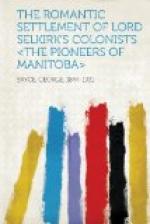“M. Provencher announced that from the next day the missionaries would begin their work and that the settlers ought to begin at the same time to work at the erection of a home for them.
“M. Lajimoniere was one of the first to meet at the place selected and to commence preparing the materials for the building. The work progressed so rapidly that the house was ready for occupation by the end of October.
“Madame Lajimoniere rendered every assistance in her power to the missionaries.”
HARGRAVE’S TALE.
With a few changes we shall allow an old friend of the writer, J.J. Hargrave, long an official of the Hudson’s Bay Company, to give the tale of the Church of England in Red River Settlement. “As we have seen, the Rev. John West came from England to Red River as chaplain of the Hudson’s Bay Company. One of his first works was the erection of a rude school-house, and the systematic education of a few children. Chief among the names of the clergymen, who came out from England in the early days of the Settlement, after Mr. West’s return, were Rev. Messrs. Jones, Cochran, Cowley, McCallum, Smedhurst, James and Hunter. William Cochran is universally regarded in the Colony as the founder of the English Church in Rupert’s Land, and from the date of his arrival till 1849 all the principal ecclesiastical business done may be said to have received its impetus from his personal energy. The church in which he began his ministrations was replaced by the present Cathedral of St. John’s. Mr. Cochran then built the first church in St. Andrew’s, at the Rapids, and besides gathered the Indians together and erected their church at St. Peter’s.”
In 1849 arrived Bishop David Anderson, an Oxford man. He settled at St. John’s, now in the City of Winnipeg, and occupied “Bishop’s Court.” After occupying the See for fifteen years, he retired, and was succeeded by Bishop Machray, whose commanding figure was known to all early settlers in Winnipeg. He revived St. John’s College and gained fame as an educationalist.
The peculiarly situated nature of the Settlement, extending in a long line of isolated houses along the banks of the river, and in no place stretching back any distance on the prairies, render a succession of churches necessary to bring the opportunity of attending within the reach of the people. Ten Church of England places of worship exist (1870) on the bank of the river. Of these, eight are within the legally defined limits of the Colony.
About the middle of December, 1866, Archdeacon John McLean commenced the celebration of the Church of England service in the village of Winnipeg. The services were for a time held in the Court House at Fort Garry, and in the autumn of 1868 Holy Trinity Church was opened in Winnipeg.




